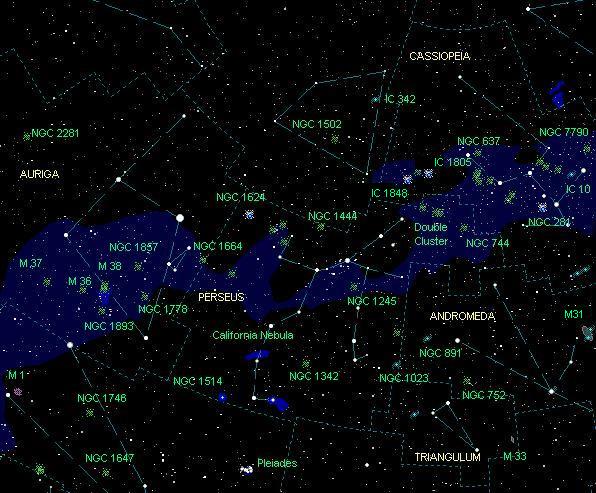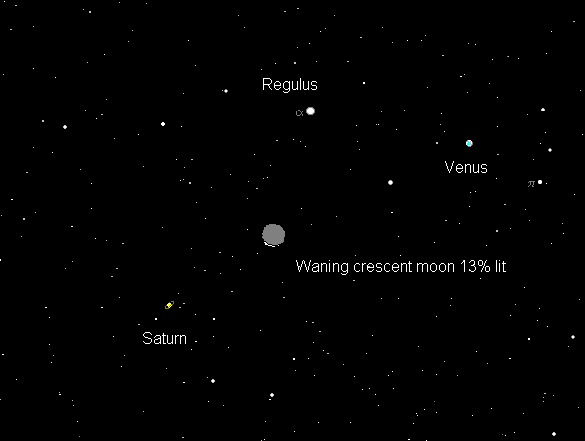Milky Way (North)
We have all enjoyed the long months of summer, especially the awe-inspiring views of the Milky Way Galaxy. This mystical glow of millions of distant suns now stands directly overhead as the sky darkens and sets before the break of dawn. This is also your last chance to catch Scorpius, the planet Jupiter and Sagittarius in that order, located in south-west skies.
Over the course of the night, as various portions of our home galaxy set in the south and west, the northern section along Cassiopeia, Perseus, and Auriga remain prominent and prime for observing. Since these constellations reside above the forty-five degrees north latitude mark, they are termed as circumpolar and thus never set as seen from Canada.

A favourite target in the north is the Double Cluster in Perseus. In a low power eyepiece, two distinct open clusters greet you. The combined light of both members equals that of a fourth magnitude star. Keep in mind this is stretched over a wide area. Their estimated distances are 7,100 and 7,400 light-years (ly) from us. Viewing the Double Cluster under very dark conditions is like seeing diamonds on black velvet.
Someone and three-quarter degrees from the Alpha star is NGC281, the Pacman Nebula. This diffuse nebula has a reddish glow is telling us it has active hydrogen molecules. NGC281 is fairly bright so it can be glimpsed in binoculars under superb dark conditions. Although there are a large number of open clusters available in this section of the sky, there are a few galaxies for your viewing pleasure. IC 10 is one such object. It is deemed as an outlying member of the Local Group of Galaxies. Lying 4.5 million ly, IC10 is 50% farther than the Andromeda Galaxy but glows at only magnitude 10.2. This galaxy possesses a large number of star-forming regions.
Moving to the eastern part of Cassiopeia’s boundary is a trio of objects. NGC 1027 is a rich open cluster measuring 2/3rd of the moon’s width. With a magnitude of 6.7, it is a guidepost to IC 1805 aka the Heart Nebula on the right and Soul Nebula on the left. Both are being lit by young and hot blue stars. The Heart and Soul Nebulas lie about 6,000 ly from us. One of the best examples of an edge-on galaxy is NGC 891. With the plane of this galaxy lined up with our planet, NGC 891 takes on a pencil-shaped appearance and exhibits the classic dust lane structure running along the outer perimeter.
NGC 1514 in Perseus is a difficult 10th magnitude planetary nebula. Astronomers believe there might be two stars in this planetary nebula orbiting each other between four to nine days. NGC 1514 measures less than 2 arc minutes across.
Keep moving from Cassiopeia through Perseus and you will land on Auriga. No less than three Messier objects take up residence here, namely M36, 37 and 38. Of the three I really like M37 with its even splash of stars. Mars is now placed at the highest part of the ecliptic with the Mighty Hunter – Orion just below it. With each passing day, our two worlds are moving closer until December 18th. At that point, the red planet will be 88 million km. Mars will become stationary on November 15 and begin its retrograde motion against the normal flow of the stars. It is now unmistakably bright being a yellowish-orange colour.
| Object | Type | Magnitude | R.A. | Dec. |
|---|---|---|---|---|
| Double Cluster | 2 open clusters | |||
| IC 10 | Open cluster | 10.0 | 00h 20m 48.7s | +59° 20' 57" |
| IC 342 | Open cluster | 9.0 | 03h 47m 36.7s | +68° 07' 52" |
| IC 1805 | Open cluster | 6.0 | 02h 33m 19.2s | +61° 29' 30" |
| IC 1848 | Open cluster | 6.0 | 02h 51m 50.2s | +60° 28' 22" |
| M 1 | Supernova Remnant | 8.4 | 05h 35m 0.9s | +22° 01' 26" |
| M 31 | Galaxy | 3.5 | 00h 43m 7.9s | +41° 18' 52" |
| M 33 | Galaxy | 5.7 | 01h 34m 21.3s | +30° 41' 40" |
| M 36 | Open cluster | 6.0 | 05h 36m 40.0s | +34° 08' 28" |
| M 37 | Open cluster | 5.6 | 05h 52m 57.7s | +32° 33' 15" |
| M 38 | Open cluster | 6.4 | 05h 29m 16.5s | +35° 50' 34" |
| NGC 281 | Nebula | 7.0 | 00h 53m 15.4s | +56° 39' 55" |
| NGC 637 | Open cluster | 8.2 | 01h 43m 27.5s | +64° 02' 48" |
| NGC 744 | Open cluster | 7.9 | 01h 58m 56.2s | +55° 31' 41" |
| NGC 752 | Open cluster | 5.7 | 01h 58m 17.0s | +37° 43' 36" |
| NGC 891 | Edge on galaxy | 10.0 | 02h 23m 6.8s | +42° 23' 29" |
| NGC 1023 | Elongated galaxy | 9.5 | 02h 40m 54.9s | +39° 06' 20" |
| NGC 1245 | Open cluster | 8.4 | 03h 15m 16.4s | +47° 17' 06" |
| NGC 1342 | Open cluster | 6.7 | 03h 32m 8.3s | +37° 21' 54" |
| NGC 1444 | Open cluster | 6.6 | 03h 50m 2.0s | +52° 41' 48" |
| NGC 1502 | Open cluster | 5.7 | 04h 08m 26.7s | +62° 21' 39" |
| NGC 1514 | Planetary nebula | 10.0 | 04h 09m 43.8s | +30° 48' 29" |
| NGC 1624 | Stars and nebula | 10.4 | 04h 41m 2.9s | +50° 28' 14" |
| NGC 1647 | Open cluster | 6.4 | 04h 46m 29.8s | +19° 05' 00" |
| NGC 1664 | Open cluster | 7.6 | 04h 51m 42.4s | +43° 43' 04" |
| NGC 1746 | Open cluster | 6.0 | 05h 04m 6.9s | +23° 49' 49" |
| NGC 1778 | Open cluster | 7.7 | 05h 08m 40.5s | +37° 03' 50" |
| NGC 1857 | Open cluster | 7.0 | 05h 20m 47.5s | +39° 21' 42" |
| NGC 1893 | Open cluster with Nebulosity |
7.6 | 05h 23m 15.7s | +33° 24' 38" |
| NGC 7790 | Open cluster | 8.5 | 05h 23m 15.7s | +33° 24' 38" |
A nice planetary grouping along with the waning crescent Moon will take place on Sunday morning before sunrise. The Moon will be nestled between Venus on the right and Saturn on the left. The brightest star of Leo finishes the portrait at the one o’clock position. Autumn is prime time to catch the Zodiacal Lights. This triangular column is light is seen in the fall in eastern skies before sunrise and springtime in the west after sunset. With the Sun lying very close to the celestial equator, the dust of the solar system is illuminated thus allowing us to view this debris along our solar system’s plane. This is comparable to looking at a dusty table edge-on. Commencing October 10th with the absence of the morning Moon, you will have a two week period to catch and photograph these phenomena.

October also plays host two a couple of meteor showers. The first is called the Draconids and it will peak on October 9th at 4:30 UT. The rates of this particular show are unpredictable being from periodic to storm levels. The Draconids, however, occur 3 nights before the new Moon so no interference. The second celestial show will be the Orionids. Although scheduled to peak on October 21st, its entire duration lasts from October 2 to November 7th. At its height, the hourly rate of 25 meteors might be seen as the waxing gibbous Moon will interfere.
Venus will slide about 3 degrees south of the ringed planet Saturn before dawn breaks on the morning of the 15th and attains greatest western elongation (highest point above the eastern horizon at 46 degrees) on the 28th.
And last but not least, Hallowe’en is on the 31st. If it is clear, set out your telescope outdoors at a bright cluster or other object and give the trick or treaters – a real treat.
Till next month – clear skies everyone
Gary Boyle
